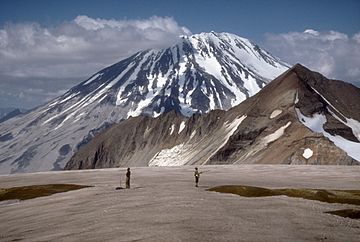Mount Griggs facts for kids
Quick facts for kids Mount Griggs |
|
|---|---|

NW view from west rim of Katmai caldera, July 1990
|
|
| Highest point | |
| Elevation | 7,602 ft (2,317 m) |
| Prominence | 7,300 ft (2,200 m) |
| Listing |
|
| Geography | |
| Location | Katmai National Park and Preserve, Lake and Peninsula Borough, Alaska, U.S. |
| Parent range | Aleutian Range |
| Topo map | USGS Mount Katmai B-4 |
| Geology | |
| Mountain type | Stratovolcano |
| Volcanic arc/belt | Aleutian Arc |
| Last eruption | 1790 BCE ± 40 years |
Contents
Mount Griggs, once called Knife Peak Volcano, is a type of volcano known as a stratovolcano. It is located about 10 kilometers (6 miles) away from other volcanoes in the Katmai area. Even though Mount Griggs has not had any big eruptions in recorded history, it still has active steam vents called fumaroles.
These fumaroles are found in the crater at the top and along the lower southwest side of the mountain. The ones on the southwest side are the hottest. Some of these vents can even make a loud roaring sound that you can hear from the valley below!
What is Mount Griggs?
Mount Griggs is a stratovolcano, which means it's a tall, cone-shaped volcano built up by many layers of hardened lava, ash, and rocks. It stands in the beautiful Katmai National Park and Preserve in Alaska. This park is famous for its volcanoes and wildlife.
A Sleeping Giant?
While Mount Griggs hasn't erupted in modern times, it's not completely quiet. The active fumaroles show that there's still heat and activity deep inside. Scientists believe its last major eruption happened around 1790 BCE, which was about 3,800 years ago.
The slopes of Mount Griggs are covered in ash and debris. This material came from a huge eruption in 1912 from a nearby volcano called Novarupta. This event changed the landscape of the area a lot.
Inside the Volcano
The very top of Mount Griggs has three craters, one inside another. The largest and lowest crater contains a newer cone, which itself has two smaller craters on top. Scientists estimate the total size of the volcano is about 25 cubic kilometers (6 cubic miles). This is a huge amount of rock and material!
Studies of the rocks from Mount Griggs show that its magma (molten rock) is different from the magma of other volcanoes nearby. This suggests it has a unique source deep within the Earth.
How Mount Griggs Got Its Name
The mountain was named after Dr. Robert Fiske Griggs (1881–1962). He was a botanist, which is a scientist who studies plants. After the massive eruption of Mount Katmai in 1912, Dr. Griggs explored the area.
His important explorations helped lead to the creation of Katmai National Monument. This special protected area was established by President Woodrow Wilson in 1918. It later became a National Park and Preserve.
Images for kids



